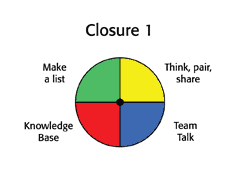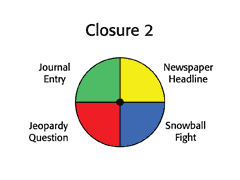
Overhead Spinner
I've been using an overhead spinner for years now. It's such a great little toy for injecting a bit of fun and drama into the day.
Four Corners
The first time I used one was to play a simple game with my students. It was a variation on the game, North, South, East, West. But instead of identifying the walls of the room by their direction, we used the colors on the spinner as the way to identify the four different corners of our classroom.

HOW TO PLAY:
- Place the overhead spinner on the projector and show the image to your students.
- Have the students figure out the colors for the four corners of your classroom.
- As the teacher is counting from 10 down to 0, the students walk toward one of the four corners. When they've reached their area, they stand and wait.
- After the teacher has reached 0, the spinner is given a spin. All students standing in that corner are out and must sit down until the next game.
- The teacher then begins to count down again as the remaining students walk to another direction. (They may stay in the same spot if they wish.)
- After counting to 0, the spinner is again given a spin. As before, students standing in the chosen corner are out.
- The teacher keeps counting (usually with the assistance of the students who are sitting in their seats) and the spinner keeps spinning until just one student is left standing.
- The last student gets to work the spinner during the next game.
Suggestion: As the game progresses and fewer and fewer students are still in the game, you might want to change the game so that both ends of the spinner are used to eliminate players. Just a thought.
Closure Activities
Research indicates that three minutes of effective closure can enhance retention by 50%.
Wow.
To make closure a bit more playful, I created a couple of closure playlists.

Make a List
Jon Pearson, a great guy who conducts workshops on creative learning, shared some surprising research with me about lists. He said that if students each make a list of what they learned, retention goes up 600%!
Think, pair, share (TPS)
Although you already know about this one, there's something you should keep in mind. Don't expect students to be able to stop a think, pair, share immediately. They need a bit of time to disengage from the dialogue and come back to attention. As much as I like to use a squeak toy or clicker as an attention-getter, using one to end a TPS is unrealistic.
Better would be to use a short song of some type. (The Andy Griffith theme song is ideal. Thirteen seconds long and easy to listen to.) By using a song to wrap up a TPS, you're not only providing them with a reasonable amount of time to disengage, you're also showing respect for the quality of their talk. After all, how appreciation was shown if the participants were made to stop instantly?
Team Talk
Like a TPS but team-based.
Knowledge Base
This is a teacher-led closure activity in which I use my set of Class Cards to call upon students to share what they learned. Challenge: Each response must be unique.

Journal Entry
Just what it sounds like.
Newspaper Headline
Similar to Journal Entry since it's a written closure activity, students need to compose a headline that encapsulates something they learned during the lesson. This really requires that they get to the heart of the matter.
Snowball Fight
Students write something they learned on a sheet of scrap paper, crumble it up, and then, at a signal, throw their "snowballs" at other students. After a brief skirmish, students unwrap a snowball and see what someone else wrote. A bit crazy but fun.
Jeopardy Question
Students create a question that is in the form of an answer. They then take turns posing their questions to the class.
![]()
Selecting Music
Find out to how to use a spinner for selecting music to play during the day.
![]()
